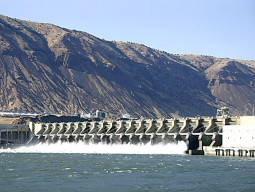
But this delta is now dying a slow death as the construction of dams for irrigation and power has choked off much of the fresh water supply. Hence, its 17 major creeks are drying out and salty water from the sea is steadily entering the basin.
The delta stretches 150km along the Arabian sea, forming a key part of Pakistan’s coastline. It is mostly located in the Badin and Thatta districts of Sindh, and is home to 97% of the country’s mangrove forests.
Read: Melting away
According to data from the Coastal Environmental Management Plan for Pakistan, the drying creeks and rising salinity are setting these forests up for a major ecological disaster. The decreasing river flow had already led to the loss of about 86% of mangrove cover between 1966 and 2003.
These forests form the backbone of the area’s delicate ecosystem, providing a breeding ground and food for various species of fish and shrimps that are a key part of Pakistan’s fisheries exports. Over the years, the rising salinity and disappearing forests have severely reduced the amount of fish and shrimp stocks available.
According to an estimate, over 1.2 million people live in River Indus’ mangrove forests, many of whom are entirely dependent on fishing or farming for their livelihood. But with fishing catches on a downward spiral and the increasing salinity of the land making farming nearly impossible, the delta’s communities face a huge crisis.
Dying dolphins
Another species at risk is the Indus river dolphin whose habitat has been steadily declining since the 1930s when the construction of dams first began. With each new dam, small groups of dolphins became trapped in parts of the river, unable to swim upstream or downstream. Many were left to die, resulting in an over 50% decline in the total population from 1944. According to estimates from the World Wildlife Fund, only 1,100 remain today.
Read: 5-year practice: WWF to assess Indus River dolphin
As the country faces a worsening water crises, for the Pakistani government, building more dams seems to be the only way forward. However, for the communities who live on the land around the river and the delta, these massive dams will make things worse.
The article originally appeared on Quartz India.



































1713853507-0/MalalaHilary-(2)1713853507-0-270x192.webp)







COMMENTS (3)
Comments are moderated and generally will be posted if they are on-topic and not abusive.
For more information, please see our Comments FAQ